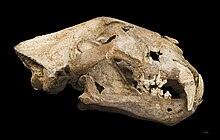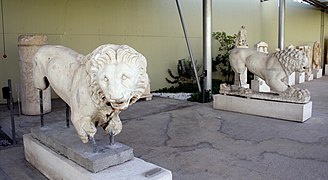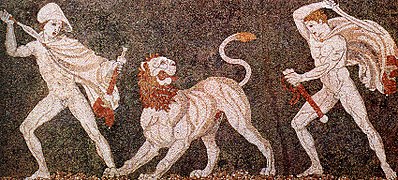History of lions in Europe


The history of lions in Europe is part of the wider history of the lion species complex. The rediscovery and confirmation of their presence in Europe, already known by myths, historical accounts and ancient art, was made possible by the finds of fossils of Pleistocene, Holocene and Ancient lions excavated in Europe since the early 19th century.[1][2] The first excavated lion fossil was found in southern Germany, and described by Georg August Goldfuss using the scientific name Felis spelaea. It probably dates to the Würm glaciation, and is 191,000 to 57,000 years old.[3] Since then, older lion skull fragments were excavated in Germany and in other parts of Europe, including in Western Europe. Some of them were described by Wilhelm von Reichenau under Felis fossilis in 1906.[4]
The oldest remains of lions in Europe, assigned to the species Panthera fossilis, are over 600,000 years old. This species represents one of the largest known felines to have ever existed, with this species eventually evolving into the smaller (around the size of a modern lion) cave lion (Panthera spelaea),[5] which is widely depicted in Palaeolithic European art like cave paintings.[6] Remains of P. fossilis and P. spelaea are known from across Europe.[5] Cave lions became extinct around 14,000 years ago at the end of the Pleistocene.[7] During the early-middle Holocene (from around 8,000-6,000 years ago) modern lions colonised Southeast and parts of Central and Eastern Europe,[8] before becoming extinct in Europe likely during classical times[9] (or perhaps as late as the Middle Ages[8]).
Lions have appeared in European literature since the times of Ancient Greece, such as in the Iliad, or with the story of the Nemean lion.[10] Ancient Greeks also depicted them in sculpture, such as with the Lion Gate of Mycenae or in the island-sanctuary of Delos, where various sculptures of lions survive to this day.[11]
During the Roman Republic and later Roman Empire, using lions in gladiatorial games and public spectacles was a prized endeavor. [12] North African Barbary lions were imported into Europe during the Middle Ages.[13]
Characteristics
[edit]Bone fragments of fossil spelaea lions indicate that they were bigger than the modern lion and had less specialized lower teeth, reduced lower premolars and smaller incisors.[14]
As indicated by numerous artistic depictions, modern lions in the Balkans had less developed manes, and lacked abdominal and lateral manes as well as limb hair. Οn the other hand, lions from Transcaucasia exhibited all these features.[15]
Distribution
[edit]Pleistocene records
[edit]The oldest fossils excavated near Pakefield in the United Kingdom are estimated at 680,000 years old, and represent Panthera fossilis.[25] Lion fossils were excavated in Spain, Portugal, Italy, Belgium, France, United Kingdom, Germany, Poland, Czech Republic, Slovakia, Hungary and Russia.[14][26][27][28] Panthera fossilis later evolved in to the cave lion (Panthera spelaea), which is known from fossils across Europe during the Late Pleistocene.[5]
The youngest unambiguous and well dated remains of cave lions are around 14,000 years old.[29]
Holocene records
[edit]Although there are some claimed records of early Holocene lion fossils from Italy, the dating of these fossils are uncertain.[30] The oldest confirmed remains of modern lion in Europe date to the early Holocene, around 8,000-6,000 years ago.[8]
A Neolithic lion tooth fragment representing the Atlantic Period was found in Karanovo, Bulgaria, and is estimated 6,000 years old.[24] In Greece, lions first appeared around 6,500–6,000 years ago as indicated by a front leg bone found in Philippi.[2] Bone fragments of the modern lion were excavated in Hungary and in Ukraine's Black Sea region, which are estimated at around 5,500 to 3,000 years old.[31] Remains were also found in Romania and European Turkey.[18]
Historic range of Panthera leo
[edit]In Southeast Europe, the lion inhabited part of the Balkan Peninsula, up to Hungary and Ukraine during the Neolithic period,[32][33] (though some authors have argued that lions may have survived in Ukraine until the Middle Ages).[8] It survived in Bulgaria until the 4th or 3rd century BCE.[34][35] Around 1000 BCE, it became extinct in the Peloponnese.[2][9] It disappeared from Macedonia around the first century CE, from Western Thrace not before the 2nd century CE and from Thessaly possibly in the 4th century CE; Themistius regretted that no more lions could be furnished for beast-shows.[32][33][2][36][23]
In Transcaucasia, the lion was present until the 10th century. The peak of its historic range covered all of the plains and foothills of eastern Transcaucasia, westward almost to Tbilisi in modern Georgia. Northwards, its range extended through the eastern Caucasus, from the Apsheron Peninsula to the mouth of the Samur River near the current Azerbaijan-Russia border, extending to the Araks river. From there, the boundary of its range narrowly turned east to Yerevan in modern Armenia, with its northern boundary then extending westward to Turkey.[15]
In culture
[edit]
Cave lions feature in a number of works of Palaeolithic art, though depictions are comparatively rare.[30] These include cave paintings, engravings, and sculptures, notably including the famous anthropomorphic lion-man figurine with a human-like body and a cave lion head.[37]
Lions feature in ancient Greek mythology and writings, including the myth of the Nemean lion, which was believed to be a supernatural lion that occupied the sacred town of Nemea in the Peloponnese.[38] Homer mentioned lions 45 times in his poems, but this could have been due to his experience in Asia Minor.[16] Phalaecus, a tyrant of Amvrakia (modern-day Arta), was allegedly killed by a female lion due to his holding a newborn lion cub, after finding it on a hunting expedition.[39] Conon refers to the myth of how Olynthus city got its name, when during around the period of the Trojan War, son of Strymon, Olynthos during a lion hunt was killed by a lion.[40] According to Herodotus lions occurred between Achelous river and Nestus, being plentiful between Akanthos and Thermi. When Xerxes advanced near Echedorus in 480 BC, the troops' camels were attacked by lions.[35] Xenophon stated around 400 BCE that lions were hunted around Mount Kissos, Pangaio, the Pindus mountains and elsewhere.[21] Aristotle in the 4th century BCE provided some data on lion distribution, behaviour, breeding and also anatomy. According to him, lions were more numerous in North Africa than in Europe; they had approached towns, and attacked people only if they were old, or had poor dental health.[20] Pliny the Elder mentions that European lions were stronger compared to those from Syria and Africa.[41] In the 2nd century CE, Pausanias referred to lion presence east of Nestus in Thrace, in the area of Abdera. He also referred to a story about Polydamas of Skotoussa, an Olympic winner in the 5th century BCE, who allegedly used his bare hands to kill a lion on Thessalian part of Mount Olympus; and to one about Caranus of Macedon who according to the Macedonians, raised a trophy that was thrown down and destroyed by a lion that was rushing down from Mount Olympus.[22]
The Romans used Barbary lions from North Africa for lion-baiting,[42] and lions from Greece for gladiatorial games.[10][23]
-
Lion sculpture, 4th century BCE, Koropi, Greece
-
Depiction of a hunting scene on a dagger found in Mycenae, Greece, 16th century BCE
-
Marble lion from Greece, mid-4th century BC
-
Depiction of the lion from the 4th century BC, Greece
-
Silver stater struck in Velia 334-300 BCE depicting Athena wearing a Phrygian helmet decorated with a centaur and lion devouring prey
-
Mosaic from Pella (ancient Macedonia), late 4th century BC, depicting Alexander the Great and Craterus.
See also
[edit]References
[edit]- ^ Diedrich, C.G. (2011). "The largest European lion Panthera leo spelaea (Goldfuss 1810) population from the Zoolithen Cave, Germany: specialised cave bear predators of Europe". Historical Biology. 23 (2–3): 271–311. Bibcode:2011HBio...23..271D. doi:10.1080/08912963.2010.546529. S2CID 86638786.
- ^ a b c d e Bartosiewicz, L. (2009). "A Lion's share of attention: Archaeozoology and the historical record". Acta Archaeologica Academiae Scientiarum Hungaricae. 60 (1): 759–773. doi:10.1556/AArch.59.2008.2.28.
- ^ Diedrich, C.G. (2008). "The holotypes of the upper Pleistocene Crocuta crocuta spelaea (Goldfuss, 1823: Hyaenidae) and Panthera leo spelaea (Goldfuss, 1810: Felidae) of the Zoolithen Cave hyena den (South Germany) and their palaeo-ecological interpretation". Zoological Journal of the Linnean Society. 154 (4): 822–831. doi:10.1111/j.1096-3642.2008.00425.x.
- ^ Reichenau, W. V. (1906). "Beiträge zur näheren Kenntnis der Carnivoren aus den Sanden von Mauer und Mosbach". Abhandlungen der Großherzoglichen Hessischen Geologischen Landesanstalt zu Darmstadt. 4 (2): 125.
- ^ a b c Marciszak, Adrian; Gornig, Wiktoria (September 2024). "From giant to dwarf: A trend of decreasing size in Panthera spelaea (Goldfuss, 1810) and its likely implications". Earth History and Biodiversity. 1: 100007. doi:10.1016/j.hisbio.2024.100007.
- ^ Russo, G.; Milks, A.; Leder, D.; Koddenberg, T.; Starkovich, B. M.; Duval, M.; Zhao, J.-X.; Darga, R.; Rosendahl, W.; Terberger, T. (2023). "First direct evidence of lion hunting and the early use of a lion pelt by Neanderthals". Scientific Reports. 13 (1): 16405. Bibcode:2023NatSR..1316405R. doi:10.1038/s41598-023-42764-0. PMC 10570355. PMID 37828055.
- ^ Stuart, A. J. & Lister, A. M. (2011). "Extinction chronology of the cave lion Panthera spelaea". Quaternary Science Reviews. 30 (17): 2329–2340. Bibcode:2011QSRv...30.2329S. doi:10.1016/j.quascirev.2010.04.023.
- ^ a b c d Marciszak, A.; Ivanoff, D. V.; Semenov, Y. A.; Talamo, S.; Ridush, B.; Stupak, A.; Yanish, Y.; Kovalchuk, O. (2022). "The Quaternary lions of Ukraine and a trend of decreasing size in Panthera spelaea". Journal of Mammalian Evolution. 30 (1): 109–135. doi:10.1007/s10914-022-09635-3. hdl:11585/903022.
- ^ a b Schnitzler, A.E. (2011). "Past and present distribution of the North African-Asian lion subgroup: a review". Mammal Review. 41 (3): 220–243. doi:10.1111/j.1365-2907.2010.00181.x.
- ^ a b c Alden, M. (2005). "Lions in paradise: Lion similes in the Iliad and the Lion Cubs of IL. 18.318-22". The Classical Quarterly (55): 335–342. doi:10.1093/cq/bmi035.
- ^ Hermary, Antoine (2020-12-01). "Sculptures archaïques de Délos : deux lions, une sirène et deux oiseaux". Bulletin de correspondance hellénique (in French). 144 (1). doi:10.4000/bch.1045. ISSN 0007-4217. Archived from the original on 2024-08-17. Retrieved 2024-08-17.
- ^ Epplett, William Christopher (2009). "Animal spectacula of the Roman Empire". University Of British Columbia. doi:10.14288/1.0090535.
{{cite journal}}: Cite journal requires|journal=(help) - ^ Barnett, R., Yamaguchi, N., Shapiro, B., & Sabin, R. (2008). Ancient DNA analysis indicates the first English lions originated from North Africa. Contributions to Zoology, 77(1), 7–16.
- ^ a b Sabol, M. (2014). "Panthera fossilis (Reichenau, 1906) (Felidae, Carnivora) from Za Hájovnou Cave (Moravia, The Czech Republic): A Fossil Record from 1987-2007". Acta Musei Nationalis Pragae, Series B, Historia Naturalis. 70 (1–2): 59–70. doi:10.14446/AMNP.2014.59.
- ^ a b Heptner, V. G.; Sludskiy, A. A. (1992) [1972]. "Lion". Mlekopitajuščie Sovetskogo Soiuza. Moskva: Vysšaia Škola [Mammals of the Soviet Union, Volume II, Part 2]. Washington DC: Smithsonian Institution and the National Science Foundation. pp. 83–95. ISBN 978-90-04-08876-4.
- ^ a b Schnitzler, A. E. (2011). Past and present distribution of the North African-Asian lion subgroup: a review. Mammal Review 41: 220−243.
- ^ Thomas, N.R. (2004). "The Early Mycenaean Lion up to Date". Hesperia Supplements (33): 161−206.
{{cite journal}}: Cite journal requires|journal=(help). - ^ a b Thomas, N.R. (2014). Touchais, G.; Laffineur, R.; Rougemeont, F. (eds.). "A lion's eye view of the Greek Bronze Age". Aegaeum. Annales Liégeoises et PASPiennes d'Archéologie égéenne (37): 375−92.
- ^ Beloe, W. (1830). "Book VII. Polymnia". Herodotus translated from the Greek. London: Jones and Co. pp. 321−380.
- ^ a b Αριστοτέλης, 4th century BCE: Των περί τα ζώα ιστοριών.
- ^ a b Ξενοφών, 5th-4th century BC: Κυνηγετικός
- ^ a b Frazer, J. G., ed. (1898). Pausanias's Description of Greece. London: Macmillan and Co.
- ^ a b c Uhm, D.P. van (2016). The Illegal Wildlife Trade: Inside the World of Poachers, Smugglers and Traders. Switzerland: Springer International Publishing.
- ^ a b Bökönyi, S. (1989). "Erster vorläufiger Bericht über Tierknochenfunde der Karanovo-V-Besiedlung in Drama". Berichte der Römisch-Germanischen Kommission (70): 123–127.
- ^ Lewis, M.; Pacher, M.; Turner, A. (2010). "The larger Carnivora of the West Runton Freshwater Bed". Quaternary International. 228 (1–2): 116–135. Bibcode:2010QuInt.228..116L. doi:10.1016/j.quaint.2010.06.022.
- ^ Marciszak, A.; Stefaniak, K. (2010). "Two forms of cave lion: Middle Pleistocene Panthera spelaea fossilis Reichenau, 1906 and Upper Pleistocene Panthera spelaea spelaea Goldfuss, 1810 from the Bisnik Cave, Poland". Neues Jahrbuch für Geologie und Paläontologie - Abhandlungen. 258 (3): 339–351. doi:10.1127/0077-7749/2010/0117.
- ^ Baryshnikov, G. and Boeskorov, G. (2001). "The Pleistocene cave lion, Panthera spelaea (Carnivora, Felidae) from Yakutia, Russia". Cranium. 18 (1): 7–24.
{{cite journal}}: CS1 maint: multiple names: authors list (link) - ^ "Pyrénées-Orientales : des ossements d'un lion de 400 kg datant de 100 000 ans découverts dans une grotte du Conflent". France 3 Occitanie (in French). 2021-07-10. Retrieved 2024-08-17.
- ^ Stuart, A. J.; Lister, A. M. (2011). "Extinction chronology of the cave lion Panthera spelaea". Quaternary Science Reviews. 30 (17): 2329–2340. Bibcode:2011QSRv...30.2329S. doi:10.1016/j.quascirev.2010.04.023.
- ^ a b Sigari, D.; Bourdier, C.; Conti, C.; Conti, J.; Forti, L.; García-Diez, M.; Lai, G.; Mazzini, I.; Pieruccini, P.; Sardella, R. (2024-06). "The last cave lion of the late Upper Palaeolithic: The engraved feline of Grotta Romanelli (southern Italy)". Quaternary Science Reviews. 334: 108670. doi:10.1016/j.quascirev.2024.108670.
{{cite journal}}: Check date values in:|date=(help) - ^ Sommer, R. S.; Benecke, N. (2006). "Late Pleistocene and Holocene development of the felid fauna (Felidae) of Europe: A review". Journal of Zoology. 269 (1): 7–19. doi:10.1111/j.1469-7998.2005.00040.x.
- ^ a b Douglas, N. (1927). Birds and Beasts of Greek Anthology. Florence: Norman Douglas. Archived from the original on 2024-08-17. Retrieved 2018-08-31.
- ^ a b Alden, M. (2005). "Lions in paradise: Lion Similes in the Iliad and the Lion Cubs of IL. 18.318-22". The Classical Quarterly (55): 335–342. doi:10.1093/cq/bmi035.
- ^ Masseti, M.; Mazza, P.P.A. (2013). "Western European Quaternary lions: new working hypotheses". Biological Journal of the Linnean Society. 109 (109): 66–77. doi:10.1111/bij.12032.
- ^ a b Guggisberg, C. A. W. (1975). "Lion Panthera leo (Linnaeus, 1758)". Wild Cats of the World. New York: Taplinger Publishing. pp. 138–179. ISBN 978-0-8008-8324-9.
- ^ Cohen, A. (2010). "Master of Lions (and other Animals)". Art in the era of Alexander the Great: Paradigms of manhood and their cultural traditions. Cambridge: Cambridge University Press. pp. 64–118. ISBN 978-0-5217-6904-4.
- ^ Russo, G.; Milks, A.; Leder, D.; Koddenberg, T.; Starkovich, B. M.; Duval, M.; Zhao, J.-X.; Darga, R.; Rosendahl, W.; Terberger, T. (2023). "First direct evidence of lion hunting and the early use of a lion pelt by Neanderthals". Scientific Reports. 13 (1): 16405. Bibcode:2023NatSR..1316405R. doi:10.1038/s41598-023-42764-0. PMC 10570355. PMID 37828055.
- ^ Hard, R. (2003). The Routledge Handbook of Greek Mythology: Based on HJ Rose's Handbook of Greek Mythology. London and New York: Routledge.
- ^ Stephens, S. Callimachus (2015). Aetia. Dickinson College Commentaries. https://ds-drupal.haverford.edu/dcc/pl/callimachus-aetia/book-3/phalaecus-ambracia[permanent dead link]
- ^ Gedoyn, A. 1738: 186 Récits de Conon.
- ^ Боев, З. 2016. Левът наш балкански. – Списание Осем, 6: 98-105.
- ^ Nowell, K.; Jackson, P. (1996). "Panthera leo" (PDF). Wild Cats: Status Survey and Conservation Action Plan. Gland, Switzerland: IUCN/SSC Cat Specialist Group. pp. 17–21, 37–41. ISBN 978-2-8317-0045-8. Archived (PDF) from the original on 2005-05-29. Retrieved 2018-02-02.
- ^ Chauvet, J.-M.; Brunel, D. E.; Hillaire, C. (1996). Dawn of Art: The Chauvet Cave. The oldest known paintings in the world. New York: Harry N. Abrams.



![Upper Paleolithic cave painting depicting cave lions, found in the Chauvet Cave, France[43]](http://upload.wikimedia.org/wikipedia/commons/thumb/2/2d/Lions_painting%2C_Chauvet_Cave_%28museum_replica%29.jpg/211px-Lions_painting%2C_Chauvet_Cave_%28museum_replica%29.jpg)







